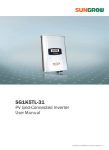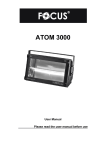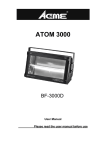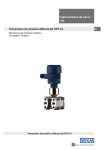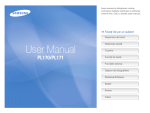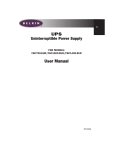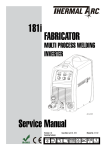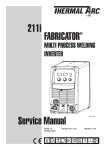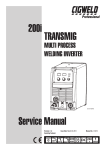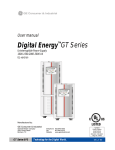Download User's Guide
Transcript
User’s Guide Power DS Series 1K/2K/3K VA Uninterruptible Power System User’s Manual Edition December, 2000 Legal Notices The information in this document is subject to change without notice. Sinetec makes no warranty of any kind with regard to this manual, including, but not limited to, the implied warranties of merchantability and fitness for a particular purpose. Sinetec shall not be held liable for errors contained herein or direct, indirect, special, incidental or consequential damages in connection with the furnishing, performance, or use of this material. Sinetec Technology Co.,Ltd 7F, No.192-1, Lien Chen Road, Chung Ho City, Taipei Hsien, Taiwan, R.O.C. Copyright Notices. Copyright 2000 Sinetec, all rights reserved. Reproduction, adaptation, or translation of this document without prior written permission is prohibited, except as allowed under the copyright laws. Warranty All Sinetec instruments are warranted against defects in material and workmanship for a period of one year after date of shipment. Sinetec agrees to repair or replace any assembly or component found to be defective, under normal use during this period. Sinetec's obligation under this warranty is limited solely to repairing any such instrument, which in Sinetec's sole opinion proves to be defective within the scope of the warranty when returned to the factory or to an authorized service center. Transportation to the factory or service center is to be prepaid by the purchaser. Shipment should not be made without prior authorization by Sinetec. This warranty does not apply to any products repaired or altered by persons not authorized by Sinetec, or not in accordance with instructions furnished by Sinetec. If the instrument is defective as a result of misuse, improper repair, or abnormal conditions or operations, repairs will be billed at cost. Sinetec assumes no responsibility for its product being used in a hazardous or dangerous manner either alone or in conjunction with other equipment. High voltage used in some instruments may be dangerous if misused. Special disclaimers apply to these instruments. Sinetec assumes no liability for secondary charges or consequential damages and in any event, Sinetec's liability for breach of warranty under any contract or otherwise, shall not exceed the purchase price of the specific instrument shipped and against which a claim is made. Any recommendations made by Sinetec for use of its products are based upon tests believed to be reliable, but Sinetec makes no warranty of the results to be obtained. This warranty is in lieu of all other warranties, expressed or implied, and no representative or person is authorized to represent or assume for Sinetec any liability in connection with the sale of our products other than set forth herein. Sinetec Technology Co.,Ltd. 7F, No. 192-1, Lien Chen Road Chung Ho City, Taipei Hsien, Taiwan Tel: 886 -2-2246-7272 Fax: 886-2-2246-7312 www: http://www.opti-ups.com E-mail: [email protected] v Safety Summary The following general safety precautions must be observed during all phases of operation, service, and repair of this instrument. Failure to comply with these precautions or specific WARNINGS given elsewhere in this manual will violate safety standards of design, manufacture, and intended use of the instrument. Sinetec assumes no liability for the customer’s failure to comply with these requirements. BEFORE APPLYING POWER Verify that the product is set to match the available line voltage and the correct fuse is installed. PROTECTIVE GROUNDING Make sure to connect the protective grounding to prevent an electric shock before turning on the power. NECESSITY OF PROTECTIVE GROUNDING Never cut off the internal or external protective grounding wire, or disconnect the wiring of protective grounding terminal. Doing so will cause a potential shock hazard that may bring injury to a person. FUSES Only fuses with the required rated current, voltage, and specified type(normal blow, time delay, etc.)should be used. Do not use repaired fuses or short-circuited fuse holders. To do so could cause a shock or fire hazard. DO NOT OPERATE IN AN EXPLOSIVE ATMOSPHERE Do not operate the instrument in the presence of flammable gases or fumes. DO NOT REMOVE THE COVER OF THE INSTRUMENT Operating personnel must not remove the cover of the instrument. Component replacement and internal adjustment can be done only by qualified service personnel. vi Safety Symbols DANGER - High voltage. Explanation: To avoid injury, death of personnel, or damage to the instrument, the operator must refer to an explanation in the instruction manual. Protective grounding terminal: To protect against electrical shock in case of a fault. This symbol indicates that the terminal must be connected to ground before operation of equipment. WARNING CAUTION The WARNING sign denotes a hazard. It calls attention to a procedure, practice, or the like, which, if not correctly performed or adhered to, could result in personal injury. Do not proceed beyond a WARNING sign until the indicated conditions are fully understood and met. The CAUTION sign denotes a hazard. It calls attention to an operating procedure, or the like, which, if not correctly performed or adhered to, could result in damage to or destruction of part or all of the products. Do not proceed beyond a CAUTION sign until the indicated conditions are fully understood and met. vii WARNING This equipment has been tested and found to comply with the limits for Class A computing device pursuant to Subpart J of Part 15 of the FCC rules. These limits are designed to provide reasonable protection against harmful interference when the equipment is operated in a commercial environment. The equipment generates, uses, and radiates radio frequency energy and, if not installed and used in accordance with the instruction manual, may cause harmful interference to radio communications. Operation of the equipment in a residential area is likely to cause interference in which case the user at his own expense will be required to take whatever measures to correct the interference. The information in this document is subject to change without prior notice in order to improve reliability, design and function and does not represent a commitment on the part of the manufacturer. Under no circumstances will the manufacturer be liable for direct, indirect, special, incidental, or consequential damages arising out of the use or inability to use the product or documentation, even if advised of the possibility of such damages. viii Table of Contents 1. Overview ................................................................................................................. 1-1 1.1 About the Product.............................................................................................. 1-1 1.2 Features ............................................................................................................. 1-1 1.3 Safety Consideration ......................................................................................... 1-2 1.4 Functions ........................................................................................................... 1-2 1.5 Front / Rear Panel.............................................................................................. 1-4 1.5.1 The Front View ...................................................................................... 1-4 1.5.2 The Rear View ....................................................................................... 1-5 1.5.3 The Connector of the Rear Panel ........................................................... 1-6 1.6 Four Keys .......................................................................................................... 1-6 1.7 Display .............................................................................................................. 1-7 2. Installation .............................................................................................................. 2-1 2.1 Precaution.......................................................................................................... 2-1 2.2 Inspection .......................................................................................................... 2-1 2.3 Setup.................................................................................................................. 2-1 2.3.1 Placing the UPS...................................................................................... 2-2 2.3.2 Providing Power Utility ......................................................................... 2-2 2.3.3 Emergency Power Off............................................................................ 2-4 2.3.4 Control & RS-232C Ports ...................................................................... 2-5 2.3.5 Extended Battery Bank........................................................................... 2-7 2.3.6 Configuration Switch ............................................................................. 2-7 2.3.7 Maintenance ......................................................................................... 2-10 3. Operation ................................................................................................................ 3-1 3.1 Introduction ....................................................................................................... 3-1 3.2 The Flowchart of Operation .............................................................................. 3-1 3.3 Checking before Power-On............................................................................... 3-2 3.4 Power-On .......................................................................................................... 3-2 3.5 Cold Start........................................................................................................... 3-2 3.6 Displaying Measurement................................................................................... 3-3 3.7 Fine Tune........................................................................................................... 3-3 3.8 Automatic Shutdown......................................................................................... 3-4 3.9 Automatic Restart.............................................................................................. 3-4 3.10 Automatic Bypass ........................................................................................... 3-4 4. Specifications .......................................................................................................... 4-1 4.1 Specifications of 110V ...................................................................................... 4-1 4.2 Specifications of 220V ...................................................................................... 4-2 4.3 Battery Run Time Chart .................................................................................... 4-4 5. Troubleshooting...................................................................................................... 5-1 Appendix A Error Messages ....................................................................................... A-1 ix Overview 1. Overview 1.1 About the Product The DS Series Uninterruptible Power System provides you with the advanced technology in the modern world to protect computer equipment, telecommunication instrument, electrical facilities, medical equipment and so on from damage or loss of data due to power line disturbance or interruption. The design philosophy of power stage is through the combination of a double-conversion circuit and a control circuit of digital signal processing for instant sampling to create continuous power for the load. 1.2 y y y y y y y y y y y y Features DSP (Digital Signal Processing) Controller The state-of-art DSP controller supplies pure and stable power for 2% distortion and 1% regulation. PFC (Power Factor Correction) PFC keeps the load-generated harmonics from reflecting back into your line source. APLL (Advanced Phase Lock Loop) APLL is automatically synchronized to the frequency of line power. Cold Start When input has no line voltage, or requires the supply of different frequency, the internal batteries in the UPS will provide spare power for output. Auto Shut Down/Auto Restart In battery mode, and under the circumstance of lower battery voltage, the UPS will be powered off automatically to prevent overdischarge. But if the line voltage recovers and auto restart is enabled, the UPS will be powered on again. Automatic Bypass Under some special circumstances such as overload, protection or failure, the main power supply will switch to the load via the built-in bypass circuit automatically. 110/220V Auto Detect (110V model) This auto detect is against wrong insertion. Fan Speed Control The built-in CPU regulates the fan speed in two stages according to the internal temperature and the amount of output power. Graphic LCD Display (2/3KVA) This particularly developed LCD is a device with display of high contrast. Measurement (2/3KVA) The UPS is capable of simple measurement. Battery Remaining Time (2/3KVA) In battery mode, the UPS can calculate the remaining time. Self-Diagnosis The CPU can be used to monitor the system’s operation. 1-1 1K/2K/3K VA UPS User’s Manual 1.3 Safety Consideration The following general safety precautions must be observed during operation, service and repair. y y y y y y Do not remove covers. The system is to be maintained by service personnel only. Install in a temperature and humidity controlled indoor area, which is free of conductive contaminants. The internal battery fuse is required to de-energize the unit before servicing. Battery circuit is not isolated from the AC input. Hazardous voltage may exist between battery terminals and ground. Mishandling of batteries may cause high energy and chemical hazard. Lead acid batteries may cause chemical hazard. 1.4 Functions Basically, the system is designed into three modes of operation: NORMAL, BATTERY, and BYPASS. In NORMAL mode, AC line power is filtered by EMI filter to reduce spike and noise. Then, it is passed to a converter. The converter rectifies and regulates the AC to a stable DC for inverter power. Then, the inverter outputs a sine wave of low distortion through pulse width modulation (PWM). When an AC fails or falls out of the specified limits, the mode of operation will switch to BATTERY mode. In BATTERY mode, the converter circuit and charge of the UPS will become inactive. The system will operate in this mode until the battery energy falls to the bottom. When power line recovers, the UPS will check its quality, trace and synchronize its frequency, and finally return to NORMAL mode. On an extreme condition or malfunction, the UPS will stay in BYPASS mode, or attempt to return to NORMAL mode. In BYPASS mode, the UPS switches from the power to AC line automatically to ensure continuous power to the load. Saving Mode: This is specially designed for 1KVA 220V. When loading is lower than 60W, the UPS will automatically switch to BYPASS mode for power saving. But when loading is higher than 80W, the UPS will boot to enter into NORMAL mode. This function can be enabled or disabled through the configuration SW on the rear panel. L Note In power saving mode, the UPS will automatically switch to BATTERY mode if power line stops, but there will be a period of time in suspension. 1-2 Overview AUTOMATI C BYPAS S EMI FILTER & SURG SUPPRESSIO E N AC IN BATTER CHARGE R BATTER Y Figure 1-1 CONVERTE R WIT PFC DC/D CONVERTE C R EMI FILTE R INVERTE DSP CONTROL CENTER CPU COMMUNICATI O INTERFAC AC OUT CONTRO IN/OU T System Block Diagram of 1K/2K/3KVA L Note The control center of 1KVA does not contain CPU. 1-3 1K/2K/3K VA UPS User’s Manual 1.5 Front / Rear Panel 1.5.1 Figure 1-2 Front View 1K/700VA-220V Front Panel Figure 1-4 1-4 Figure 1-3 1KVA-110V Front Panel 2/3KVA Front Panel Overview 1.5.2 Rear View Figure 1-5 1KVA-220V Rear Panel Figure 1-6 1KVA-110V Rear Panel CAUTION: RISK OF ELECTRIC SHOCK HAZARDOUS LIVE PARTS INSIDE THIS UPS ARE ENERGIZED FROM BATTERY SUPPLY EVEN WHEN THE INPUT AC POWER IS DISCONNECTED. RISK OF ELECTRIC SHOCK, DO NOT REMOVE COVER.NO USER SERVICEABLE PARTS INSIDE REFER SERVICING TO QUALIFIED SERVICE PERSONNEL. TO REDUDE THE RISK OF ELECTRIC SHOCK AND FIRE, DO NOT CONNECT TO A CIRCUIT OPERATING AT MORE THAN 150 VOLTS TO GROUND. LISTED **** DANGER: RISK OF ELECTRIC SHOCK, DO NOT TOUCH UNINSULATED BATTERY TERMINAL. Figure 1-7 2/3KVA-220V Rear Panel Figure 1-8 2/3KVA-110V Rear Panel 1-5 1K/2K/3K VA UPS User’s Manual 1.5.3 Connectors on the Rear Panel INTERFACE OPTION RS-232C 4321 SAVE MODE 1 ENABLE DISABLE DC FREQ SETTING 60Hz 50Hz 2 3 VOLTAGE 4 SETTING 220 230 240 AMERICAN + IEC GERMAN BRITISH FRENCH AUSTRALIAN EXT. BATTERY 36VDC ++ OUTPUT WARNING! TO REDUCE THE RISK OF FIRE. REPLACE ONLY WITH THE SAME TYPE AND RATING OF FUSE PART NO : SERIAL NO: INPUT CAPACITY :1KVA/0.7KW ψ0.7 COS INPUT :160 274VAC,50/6 0Hz FUSE :6.3A 250 6A MAX OUTPUT :220/230/240 VAC/T 4.5 VAC,50/60Hz FUSE :10A /4.3/4.2 A 250VAC CAUTION! RISK OF ELECTRIC SHOCK HAZARDOUS LIVE PARTS INSIDE THIS UPS ARE ENERGIZED FROM BATTERY SUPPLY EVEN WHEN THE INPUT AC POWER IS DISCONNECTED LEAD ACID BATTERY INSIDE THE ENCLOSURE Figure 1-9 1.6 Connectors on the Rear Panel Four Keys ON/OFF: Press this key for 1 second to turn on the UPS (1KVA), and press it again for 1 second to turn off. Test/Buzzer Off: Press this key in NORMAL mode, the UPS (1KVA) will enter into BATTERY mode, and count the time to 6 minutes, or to Battery Low status, and then return to NORMAL mode. If the test time (to Battery Low) is less than 3 minutes, the UPS will issue a warning message to remind you to change the battery. During test you can press this key again to interrupt. When the buzzer sounds, you can also press it to turn off. ON/OFF: Press this key to turn on the UPS (2/3KVA), and press it again to turn off. Buzzer On/Off on the Rear Panel: This key controls the sound of buzzer and the fine tune of output voltage for the UPS (2/3KVA). For voltage adjustment see 3.6. 1-6 Overview 1.7 Display Saving Mode Figure 1-10 1KVA-110V LED Display Figure 1-11 1KVA-220V LED Display 1-7 1K/2K/3K VA UPS User’s Manual Battery Bypass Mode Normal Overload System Charge Status Buzzer Status Load Input Status Battery Output Status Remaining Time Time Curren Frequency Power Voltage Figure 1-12 2/3KVA LCD Display NORMAL MODE : BATTERY MODE : BYPASS MODE : FAULT : SAVING MODE : CHARGE OVER LOAD : : 1-8 The UPS is in normal mode. It provides stable power in the specification via the inverter to output. The UPS is in battery mode. It provides stable voltage in the specification via the inverter to output. When the indicator blinks, it means batteries need changing. During power-on or when protection occurs, the UPS will enter into bypass mode. It means system failure (see error codes). The system may be in Bypass Mode, Output Off or Shutdown. The UPS will enter into power saving mode when it is lower than 60W. The LED will be lit. The batteries are on charge. The output current or power is in overload status. When overload is 101% ∼ 125%, the FAULT light will blink. When overload is 126% ∼ 150%, the FAULT light will be lit. Overview LOAD BAR : Five segments show the percentage of output power. ≥10% BATTERY CAPACITY : : INPUT VOLTAGE INPUT CURRENT INPUT POWER INPUT FREQUENCY OUTPUT VOLTAGE OUTPUT CURRENT OUTPUT POWER OUTPUT FREQUENCY : : : : : : : : ≥50% ≥70% ≥90% Five segments show the percentage of battery capacity. 20% REMAINING TIME ≥30% 40% 60% 80% 100% In battery mode count down the remaining battery capacity by minute. The data is for reference only based on the battery’s type, brand, life, temperature, and error made during discharge. The bank time calculation will be inaccurate when using extended battery. XX.X min indicates the remaining time of discharge. XXX V indicates the input voltage. XX. X A indicates the input current. X.X Kw indicates the actual input power. XX.X Hz indicates the input frequency. XX.X V indicates the output voltage. XX.X A indicates the output current. X.X Kw indicates the actual output power. XX.X Hz indicates the output frequency. The above values are a little different in display, so they are for reference only. 1-9 Installation 2. Installation 2.1 Precaution This manual contains IMPORTANT SAFETY INSTRUCTIONS, so please KEEP THE INSTRUCTIONS for future reference. y y y y Do not remove the covers Only qualified personnel can remove the covers. Ventilation Openings Do not block the ventilation openings and open the covers during operation as this may cause malfunction when temperature rises. Never install in any of the following places, where − the temperature and humidity are out of specification. − the sunlight is direct, or the heat sources are near. − an excessive amount of soot, steam, dust, or corrosive gases are present. − high voltage or strong magnetic field sources are near. Avoid using unbalanced load, half rectifier, or motor load such as dryer, starter, etc. 2.2 y y y Inspection Inspect if the packing material is broken, polluted to affect the machine. Unpack the machine carefully and inspect it. If you find the machine is damaged, please keep the packing material, notify the carrier at once, and contact the nearest agent or distributor for appropriate actions. Check if the items and amount matches the packing list. 2.3 Setup The setup is divided into physical part (see 2.3.1) and electrical part (see 2.3.2, 2.3.3, 2.3.4, 2.3.5, 2.3.6, 2.3.7, 2.3.8). Please install in accordance with the following steps. WARNING WARNING 1. 2. Only qualified personnel authorized by manufacturer can perform the installation. This unit is to operate by any individuals with no previous training. 2-1 1K/2K/3K UPS User’s Manual 2.3.1 Placing the UPS Place the UPS at a location as shown in Figure 2-1 or 2-2, and be sure that the air circulation is good. Figure 2-1 Top View of Installing 1KVA y y y y y Figure 2-2 Top View of Installing 2/3KVA The base for placing the UPS must be flat, hard, and can stand the weight of the UPS. The temperature in operation environment is from 0°C to 40°C. The humidity in operation environment is from 10% to 90% (non-condensing). The temperature for storage is from −20°C to 60°C. If there is one or more than one extended battery banks (optional), please place them close to the UPS as much as possible. CAUTION Do not cover the vent at the side of the UPS. 2.3.2 2.3.2.1 y y 2-2 Providing Power Utility The UPS The system adopts single phase, 3-line power source (1∅, 2W + GND). Be sure to use the attached power cord. Installation Figure 2-3 The Connection of Power Cord Figure 2-4 Power Utility CAUTION To reduce the risk of fire, connect over current protection according to the National Electrical Code ANSI/NFPA 70. y The measured AC voltage between neutral and ground should be below 30Vac. If not so, improve the grounding quality. 2-3 1K/2K/3K UPS User’s Manual WARNING Disconnecting the ground system may cause potential shock hazard to operators. 2.3.2.2 Power off the UPS before adding the extended battery bank. Use the attached power cord without fail. Detail installation procedures, please refer to section 2.3.5. INPUT 1 ↑ ENABLE ↓ DISABLE 3 4 ↑ 60Hz ↓ ↓ 100 ↓ ↑ 220 110 OUTPUT ↓ 50Hz ↑ ↓ 230 115 ↑ ↑ 240 120 + EXT. BATTERY 36VDC ++ --+ OUTPUT DC DC -++ SAVE MODE DC FREQ SETTING 2 VOLTAGE SETTING INTERFACE OPTION RS-232C -++ 4321 --+ y y y The UPS and the Extended Battery Bank (FROM EXT. BATTERY) (TO UPS or EXT. BATTERY) CAUTION RISK OF ELECTRIC SHOCK DO NOT REMOVE COVERS. THIS SYSTEM IS TO BE SERVICED BY QUALIFED SERVICE PERSONNEL ONLY. THE BATTERY PRESENTS A RISK OF ELECTRIC SHOCK AND ENERGY HAZARD. MISHANDLING OF BATTERIES MAY CAUSE HIGH ENERGY AND CHEMICAL HAZARD,REFER TO THE MANUAL FOR SAFE HANDLING AND DISPOSAL INSTRUCTIONS. THIS BATTERY ASSEMBLY CONTAINS SEALED LEAD ACID BATTERIES. THE CAPACITY IS 7Hr. WARNING! TO REDUCE THE RISK OF FIRE. REPLACE ONLY WITH THE SAME TYPE AND RATING OF FUSE PART NO : SERIAL NO: INPUT CAPACITY :1KVA/0.7KW COSψ 0.7 INPUT :160~274VAC,50/60Hz 6A MAX :6.3A 250 VAC/T :220/230/240 VAC,50/60Hz 4.5/4.3/4.2 A FUSE :10A 250VAC FUSE OUTPUT CAUTION! RISK OF ELECTRIC SHOCK HAZARDOUS LIVE PARTS INSIDE THIS UPS ARE ENERGIZED FROM BATTERY SUPPLY EVEN WHEN THE INPUT AC POWER IS DISCONNECTED "LEAD-ACID BATTERY INSIDE THE ENCLOSURE" HAZARDOUS VOLTAGE MAY EXIST BETWEEN BATTERY TERMINALS AND GROUND. THE PROTECTIVE EARTH TERMINAL MUST BE CONNECTED TO GROUND. FOR CONTINUED PROTECTION AGAINST FIRE HAZARD REPLACE ONLY WITH THE SAME TYPE AND RATING OF FUSE. DISPOSE OF THE BATTERY PROPERLY AT AN APPROPRIATE RECYCLING FACILITY. ACHTUNG RISIKO EINES ELEKTRISCHEN SCHLAGES BITTE ABDECKUNG NICHT ENTFERNEN. DIESES SYSTEM DARF NUR VON QUALIFIZIERTEN SERVICETECHNIKERN GEWARTET WERDEN. DIE BATTERIE BIRGT EINE GEFAHR EINES ELEKTRISCHEN SCHLAGES UND SEHR HOHER KURZSCHLUSSSTROEME. FALSCHE BEHANDLUNGEN DER BATTERIE KOENNEN HOHE ENERGIE UND CHEMIESCHE REAKTIONEN FREIWERDEN LASSEN. BITTE SICHERHEITSHINWEISE IN DER BETRIEBSANLEITUNG BEACHTEN,DIE JEDEM BENUTZER ZUR VERFUEGUNG GESTELLT WERDEN MUSS DIESE BATTERIEZUSAMMENSTELLUNG ENTHAELT VERSIEGELTE BLEI-SAEURE-BATTERIEN. DIE LADUNG BETRAEGT SIEBEN STUNDEN. GEFAEHRLICHE SPANNUNG KANN ZWISCHEN DEN BEIDEN POLEN DER BATTERIE UND DER ERDE AUFTRETEN. DER SCHUTZERDLEITER MUSS AN DER ERDUNGSKLEMME ANGESCHLOSSEN WERDEN. FUE KORREKTEN SCHUTZ GEGEN FEUER ERSETZEN SIE DIE SICHERUNG NUR MIT EINE VOMGLEICHEN TYP. ENTSORGEN SIE DIE BATTERIE BEI EINER ZUSTAEDIGEN ENTSORGUNGSSTELLE. NOTE: TYPE OF BATTERY YUASA SUNRISE PANASONIC CSB HITACHI NP7-12\250 LCR 12V 7.2S1 LCR 12V 7.2P1 GP/FR 1270F2 HV7-12F2 SERIAL NO: MODEL NUMBER VOLTAGE 91BK-7 6PCS 36VDC 91BK-10 3PCS 36VDC CAPACITY CHOICE 7AH 7AH Pb Pb Figure 2-5 The UPS and the Extended Battery Bank 2.3.3 Emergency Power Off For safety, operators can remotely power off the UPS during emergency through an external customer supplied switch. 2-4 Installation Figure 2-6 y y y y Remote EPO Installation Pin definition Pin 5: Interface GND. Pin 9: External switch for EPO function. Switch type A temporary contact switch is larger than the capacitor of 120V/100mA and color-coded with red push-button in yellow background. Switch device must be clearly marked with Emergency Power Off and placed for easy access. The extra components like switch, wire and connector are customer-supplied. WARNING Do not add voltage to pin 5 and pin 9. CAUTION The voltage is about 9V when EPO circuit and shutdown control port are open. 2.3.4 Control & RS-232C Ports In 2/3K UPS there are two 9-pin D-SUB connectors: contact closure relay and RS-232C port. In 1K there is only one 9-pin D-SUB connector for these two functions. 2-5 1K/2K/3K UPS User’s Manual 2.3.4.1 Control Port The contact closure relay is for signal output. It can connect your computer, local area network (LAN), and control system. You can accomplish the wire connection using the accessories or make them by yourself according to Figure 2-7 (on page 2-8). Pin Definition (2/3K) Pin 1: UPS OFF Pin 2: INPUT FAIL Pin 3: BYPASS Pin 4: COMMON Pin 5: LOW BATTERY Description UPS makes inverter OFF for protection. When input power does not meet the input conditions. When UPS is in Bypass Mode. It is for all pins. When the battery voltage inside UPS is too low. Pin Definition (1K/700) Description Pin 1: UPS OFF IN BYPASS When UPS is in Bypass Mode. Pin 4: COMMON It is for pin 1, pin 6 and pin 8. Pin 5: INTERFACE GND When the battery voltage inside UPS is too low. Pin 6: LOW BATTERY It is for all pins. Pin 7: POWER OFF Power off UPS. Pin 8: INPUT FAIL When input power does not meet the input conditions. Pin 9: EPO Power off UPS in an emergency. Normally the relay is OFF (open) but will be ON (close) when any condition occurs. y y y The length of the control line cannot exceed 50 meters. The rating of relay contact: Voltage: 250 Vac or 28 Vdc Max Current: 1 Amp Max The contact relay and control circuits are electrically insulated from the UPS. 2.3.4.2 RS-232C Port Pin Definition (1K) Description Pin 2: Txd Data communication of RS-232C Pin 3: Rxd Data receiving of RS-232C Pin 5: Grounding Grounding of RS-232C When using SNMP, RS-232C port will be disabled automatically; that is, these two cannot be used together. You can transfer the data (see Figure 2-7) by connecting the standard RS-232C port on UPS to an IBM compatible PC or the remote SNMP through the optional accessories. Communication Settings Control Baud Rate Data Bits 2-6 Setting 2400 8 Installation Parity Stop Bit None 1 CAUTION CAUTION Make sure that the UPS and the PC are powered off before connecting the power cord. 2.3.5 Extended Battery Bank The DS UPS can prolong backup time with additional battery banks (optional) installed. CAUTION To avoid electric shock, only qualified personnel are allowed to install the extended battery bank. 1. 2. Before installing the extended battery bank, measure the difference between the battery voltage inside the UPS and the extended battery voltage. When voltage difference is more than 2 Vdc, turn on the UPS to charge the internal battery and raise the voltage, or turn off AC power to let the UPS enter into BATTERY mode to lower the voltage. Only when voltage is the same can you connect. CAUTION If the difference between the battery voltage in the UPS and the extended battery voltage is too large, the connection may cause shock and inrush current, and damage the connector. 2.3.6 Configuration Switch When the DS series UPS is turned on, it will detect the configuration of CONFIG SW on the rear panel to initiate the operating mode. CAUTION Only qualified personnel are allowed to configure the switch. WARNING Wrong configuration may cause malfunction, or damage the equipment. Adjust the configuration of CONFIG SW according to actual function and your need. 2-7 1K/2K/3K UPS User’s Manual CONFIG SW 4321 INTERFACE OPTION RS-232 PORT 1 ↑ ENABLE ↓ DISABLE SYSTEM FREQ.(COLD START) 2 OUTPUT VOLTAGE SELECT 3 4 ↑ 60Hz ↓ ↓ 100 ↓ ↑ 110 ↓ 50Hz ↑ ↓ 115 ↑ ↑ 120 EXTERNAL BATTERY + ++ AC OUTPUT FUSE LISTED **** MODEL NO: T15A 250VAC SAVE MODE 1 ↑ ENABLE ↓ DISABLE DC FREQ SETTING 2 3 4 VOLTAGE SETTING ↑ 60Hz ↓ ↓ 100 ↓ ↑ 220 110 ↓ 50Hz ↑ ↓ 230 115 ↑ ↑ 240 120 AC INPUT SERIAL NO: :80-138VAC,50/60Hz 12A MAX :T15A 250 VAC :100/110/115/120VAC,50/60Hz 1KVA/0.7KW PF=0.7 EXTERNAL BATTERY :36VDC FUSE OUTPUT MANUFACTURER:CHROMA ATE INC. CAUTION: RISK OF ELECTRIC SHOCK HAZARDOUS LIVE PARTS INSIDE THIS UPS ARE ENERGIZED FROM BATTERY SUPPLY EVEN WHEN THE INPUT AC POWER IS DISCONNECTED. RISK OF ELECTRIC SHOCK DO NOT REMOVE COVER. NO USER SERVICEABLE PARTS INSIDE REFER SERVICING TO QUALIFIED SERVICE PERSONNEL. WARNING: TO REDUCE THE RISK OF FIRE , REPLACE ONLY WITH THE SAME TYPE AND RATING OF FUSE. Figure 2-7 3 INPUT 3 The Control Port, RS-232C Port and the Table of CONFIG SW (1KVA) L Note Any changes of setting will take effect after the UPS is restarted. Definition of Configuration Switch (1KVA) SW1: Saving Mode It switches the UPS to BYPASS mode to save power when it is (220V) not connected with a load, or the loading is lower than 60W. The setting can be changed even when the UPS is ON. SW1: System On The switch is designed to protect the UPS from wrong touch (110V) during transportation. Only when the switch is ON can the system work normally (the default is OFF). SW2: Frequency When using the cold start facility, you can choose 50 or 60 Hz as the output frequency using this switch (for cold start only). SW3: Volt. Select (Bit2) Choose a suitable output voltage range by combining these two SW4: Volt. Select (Bit1) switches. CAUTION Set the correct voltage you need before operation. 2-8 Installation Figure 2-8 The Control Port, RS-232C Port and the Table of CONFIG SW (2/3KVA) Definition of Configuration Switch (2/3KVA) SW1: System On The switch is designed to protect the UPS from wrong touch of during transportation. Only when the switch is ON can the system work normally (the default is OFF). SW2: Fine Tune When switch is ON, you can adjust the output voltage up or down using the buzzer switch. SW3: Cold Start Under the circumstance of no AC power input, if you want to output AC power by starting the batteries inside the UPS, you can set the switch ON. However, when the AC power meets the conditions for input, the function is ineffective. SW4: Frequency When the conditions for cold start are established, you can choose 50 or 60 Hz as the output frequency using this switch (for cold start only). SW5: Synchronized Range Select Sync frequency between input and output. In an area where frequency is unstable, you can choose the range of 3 Hz, whereas in an area of stable frequency, you can choose the range of 1 Hz. SW6: Voltage Select (Bit 3) Choose the fit range of output voltage using the combination SW7: Voltage Select (Bit 2) of these three switches. SW8: Voltage Select (Bit 1) 2-9 1K/2K/3K UPS User’s Manual 2.3.7 1. 2. 3. Maintenance Cleaning y Please clean the panels and the machine with non-volatile liquid on soft cotton cloth. y Inspect the cleanness of the air intake regularly, and clean it with a vacuum cleaner. Maintenance y Only qualified technicians or service personnel can perform the maintenance. Battery Replacement y Generally a newly purchased set of batteries can last for three to five years. WARNING To change batteries, please contact the dealer, and let service personnel do it. change it alone. y y y y 4. 2-10 Do not Do not open or destruct batteries, for the electrolyte is toxic to skin and eyes. Recycle properly according to the local codes on the batteries. The batteries must be replaced with the same type and rating. The batteries fit for use are: YUASA NP7-12\250 CSB GP1270/1272 F2 PANASONIC LCR 12V 7.2S1 HITACHI HV7-12 F2 SUNRISE LCR 12V 7.2P1 B.B. BP7.5-12/ 8-12 y Hazardous voltage may exist between battery terminals and ground. Test it before touching. Replacement Procedures y Power off the UPS and input power. Remove the wiring and signal connectors of the UPS input and output power. y Open the cabinet cover of UPS properly according to the service manual. y Remove all connectors between the batteries and PCB. y Remove the connecting wires between batteries one by one. y Pull out old batteries (do not make polarity short circuit), recycle them, and get replacements. y Connect the batteries according to the wiring graph in service manual. All batteries are in series. y Measure the total voltage of batteries in series within ±10% of the specifications (see Chapter 4). y Connect the connectors back to PCB. Notice that if polarity is not correct, components will be burned. Small sparks inside batteries and PCB connectors are normal. y Replace the outer cabinet, and recover the original wiring. Installation Figure 2-9 The Battery Connecting Wires in 1KVA 2-11 1K/2K/3K UPS User’s Manual BLUE RED BLUE BLACK BLACK RED back 220V front back 110V Figure 2-10 The Battery Connecting Wires in 2KVA front BLUE RED BLACK BLACK RED BLUE back 2-12 220V front back 110V Figure 2-11 The Battery Connecting Wires in 3KVA front Operation 3. Operation 3.1 Introduction In order to make the DS series UPS user-friendly, the “Power Switch” is designed on the front panel. Under the operation of a microcomputer, the UPS offers functions like Mode Transfer, Feed Back, Control Display, Communication, and Protection automatically. Once the UPS is powered on, it will act as a guard to protect your equipment from lots of power problems. This chapter guides you how to use the UPS step by step. 3.2 The Flowchart of Operation Power Switch On : Status AC Restart : Happening Self-Check Bypass Mode Cold Start Normal Start AC Fail Battery Mode Normal Mode AC Back UPS Fail Fatal Error UPS Fail Bypass Mode Fatal Error Power Switch Off System Shutdown Figure 3-1 The Operation Flowchart The flowchart may vary slightly from your mode due to the policy of ongoing design and development. 3-1 1K/2K/3K UPS User’s Manual 3.3 Checking before Power-On In order to avoid the failure or damage caused by accidental mistakes, you should check the following list before power-on. Checkpoint Are the Input/Output cables secured? Is the Input/Output grounding correct? Has the wiring of options been completed and tested? Has the desired output voltage been set? Has Sync Range been set? (2/3K) Has Cold Start been set? (2/3K) Has SW 1 System-On been started? (2/3K) Has input circuit breaker been off? (2/3K) Has saving mode been set? y y y y y y y y y 3.4 Result Power-On CAUTION After powering off the input circuit breaker, wait for one minute at least to power it on. Everything is supposed to be set correctly before pressing the power switch. 1. 2. 3. 4. 5. 6. Power on the input circuit breaker. Press the power switch on the front panel. The system does the self-test automatically. LCD shows the software versions of DSP and CPU. LCD shows the value of input voltage. The UPS enters into Bypass Mode. When AC power meets the fit conditions and finishes synchronization, LCD will show the value of output voltage, and the UPS will enter into Normal Mode. CAUTION The backup time in Battery Mode will be reduced if batteries are not fully charged. 3.5 1. 2. 3. 3-2 Cold Start Following lists the conditions to use cold start. c There is no AC power, or the power does not meet the input specification. d SW 3 of Configuration SW is in the position of ON (Enable). Perform the first two steps in section 3.4. When self-test is completed, and the conditions of cold start are met, the UPS will switch Operation to Battery Mode automatically. CAUTION The UPS will switch to Normal Mode automatically when the system is started by cold start; the line power recovers, and meets the conditions of input as well as frequency. 3.6 Displaying Measurement The UPS provides a variety of power measurements. It can easily read the values of voltage, current, frequency as well as power, and display them on LCD. 1. In Normal Mode or Battery Mode, press and hold the buzzer switch on the rear panel for 3 seconds. The displayed item will change every 1.5 seconds. Release the buzzer switch after choosing the item you want, and the light will stay at the item. BUZZER SW * Hold For 3 Sec. START OUT IN V OUT V IN Figure 3-2 2. A A OUT Hz OUT Kw IN Hz IN Kw The Sequence of Displayed Items When operating in Battery Mode, if release SW, the displayed value will return to the remaining time of battery capacity. CAUTION All measured values are for reference only. 3.7 Fine Tune In order to cope with all kinds of installation sites, voltage drop, and the change or limit of 3-3 1K/2K/3K UPS User’s Manual input voltage from equipment, the DS series UPS can adjust the output voltage with simple setting, and make it reach ± 5Vac max by 1Vac step. 1. 2. 3. In Normal Mode, and when LCD displays output voltage (set it according to section 3.6 if the displayed status is not output voltage), set SW 2 to ON (Enable). The segment of last digit blinks when the fine tune is in process. STEP-DOWN: Keep on pressing buzzer switch, and the output voltage will lower 1Vac per 1.5 seconds. STEP-UP: Interrupt for 0.5 second, then press buzzer switch, and the output voltage will raise 1Vac each time. Set SW 2 back to OFF (Disable) after the adjustment. CAUTION The output voltage in Battery Mode is same as that after fine tune, but in this mode there is no fine tune function. 3.8 Automatic Shutdown In Battery Mode and under the circumstance of lower battery voltage, the system will shut the inverter off, keep minimum power consumption, and display error messages. If AC power does not recover after a period of time, the system will shut down automatically to protect the batteries from overdischarge. CAUTION Automatic shutdown will work when some protections happen. 3.9 Automatic Restart After automatic shutdown, if AC power recovers, and is in the specification, the UPS will restart again. If you need to cancel the function of automatic restart, please set the power switch to OFF. CAUTION The interval between automatic shutdown and restart should not be less than one minute. 3.10 Automatic Bypass The UPS has a built-in bypass circuit, which can switch itself to line power for the load 3-4 Operation automatically so as to reduce the risk of blackout when it is under abnormal condition. bypass will switch to line power automatically under the following circumstances. The c Initial power-on in NORMAL mode. d Overload: 101 ∼ 125 % over 60 Sec. 126 ∼ 150 % over 10 Sec. e The UPS temperature is Over. f The UPS is abnormal. The UPS will try to return to NORMAL mode if it has been switched to BYPASS mode because of encountering the circumstances mentioned above. If the condition occurs thrice consecutively, the UPS will stay in BYPASS mode until the system is reset CAUTION Before powering on, please check if the capacity of the equipment exceeds that of Bypass. 3-5 Specifications 4. Specifications 4.1 Specifications of 110V System Specifications Model Power Capacity Operation Topology Control Topology 1000DS 2000DS 1000VA/700W DSP 3000DS 2000VA/1400W 3000VA/2100W True On-line, double conversion DSP with CPU Control Input Number of Phase Nominal Input Voltage Input Voltage Range Nominal Input Freq. Frequency Range Power Factor Single (1∅ 2W +G) 100/110/115/120 Vac 80-138 Vac 84-138 Vac 50/60 Hz (auto sensing) 45-65 Hz 50/60 Hz±5% >0.97 @ full load >0.98 @ full load Output 100/110/115/120 Vac 20A 30A Single (1∅2W +G) < 1% < 2% (linear load) 3 Hz 1 or 3 Hz ±5%@100% load change ±4% @100% load change Transient Response Time 1 ms 3:1 Crest Factor >84% (full load) >86% (full load) Efficiency Frequency Regulation +/− 0.1 Hz (during mains failure) Yes Auto Sync 125 % for 1 min. Overload Capacity 150 % for 30 sec. 300 % for 3 sec. 0 ms Transfer Time circuit breaker Output Protection Yes Short Protection Nominal Output Volt. Output Current Number of Phase Voltage Regulation Voltage T.H.D Sync Range Dynamic Response 10A Regulatory Compliance UL 1778, CSA22.2, VCCI FCC, Part 15, Class A IEEE587 Safety EMC Verification Electromagnetic Immunity Battery Number of Battery Battery Voltage Battery Run Time (full/half load) Charge Time (to 90%) Battery Type 3 pcs 36 Vdc 7/18 min 6 pcs 72 Vdc 7/18 min 8 pcs 96 Vdc 6/15 min < 4 hr. 12V 7AH maintenance-free lead acid 4-1 1K/2K/3K UPS User’s Manual Features Auto Shutdown AC Auto Restart Cold Start Output Fine Tune Fan Speed Control Emergency Power Off Shutdown Control Auto Bypass Serial Interface V, I, P, F Meters Battery Meter Error Messages Display Yes Yes Yes Yes Yes Yes Yes Yes Yes No Yes Yes Yes graphic LCD display with LED back light LED display Others Operating Temperature Operating Humidity Audible Noise Dimensions(W×D×H) Weight 4.2 0° to 40°C 10% to 90% none condensing <45 dbA <50 dbA <50 dbA 145×405×222mm 216×616×678mm 216×616×678mm 14.7 Kgs 30 Kgs 36 Kgs Specifications of 220V System Specifications Model Power Capacity Operation Topology Control Topology 1000DS 1000VA/700W DSP 2000DS 3000DS 2000VA/1400W 3000VA/2100W True On-line, double conversion DSP with CPU Control Input Number of Phase Nominal Input Voltage Input Voltage Range Nominal Input Freq. Frequency Range Power Factor Single (1∅ 2W +G) 220/230/240 Vac 160-274 Vac 50/60 Hz (auto sensing) 45-65 Hz 50/60 Hz±5% >0.97 @ full load >0.98 @ full load Output Nominal Output Volt. Output Current Number of Phase Voltage Regulation Voltage T.H.D Sync Range Dynamic Response Transient Response Time Crest Factor Efficiency Frequency Regulation Auto Sync Overload Capacity 4-2 4.5A 3 Hz ±5%@100% load change 220/230/240 Vac 8.3A 12.5A Single (1∅2W +G) < 1% < 2% (linear load) 1 or 3 Hz ±4% @100% load change 1 ms 3:1 >84% (full load) >86% (full load) +/− 0.1 Hz (during mains failure) Yes 125 % for 1 min. 125 % for 1 min. 150 % for 10 sec. 150 % for 30 sec. Specifications 300 % for 3 sec. 300 % for 3 sec. 0 ms circuit breaker Yes Transfer Time Output Protection Short Protection Regulatory Compliance Safety EMC Verification CE Marking Electromagnetic Immunity IEC 950/EN 50091-1-1 EN 50091-2 Yes IEC 1000-4-2/IEC 801-2 ESD level 3 IEC 1000-4-3/IEC 801-3 RS level 2 IEC 1000-4-4/IEC 801-4 EFTlevel 2 IEC 1000-4-5/IEC 801-5 SIR level 3 (1K/700VA) IEC 1000-4-5/IEC 801-5 SIR level 4 (2/3KVA) Battery Number of Battery Battery Voltage Battery Run Time (full/half load) Charge Time (to 90%) Battery Type 3 pcs 36 Vdc 7/18 min 6 pcs 72 Vdc 7/18 min 8 pcs 96 Vdc 6/15 min < 4 hr. 12V 7AH maintenance-free lead acid Features Auto Shutdown AC Auto Restart Cold Start Output Fine Tune Fan Speed Control Emergency Power Off Shutdown Control Auto Bypass Serial Interface V, I, P, F Meters Battery Meter Error Messages Display Yes Yes Yes Yes Yes Yes Yes Yes Yes No LED display Yes Yes Yes graphic LCD display with LED back light Others Operating Temperature Operating Humidity Audible Noise Dimensions(W×D×H) Weight 0° to 40°C 10% to 90% non-condensing <45 dbA <50 dbA <50 dbA 145×405×222mm 216×616×678mm 216×616×678mm 14.7 Kgs 30 Kgs 36 Kgs 4-3 1K/2K/3K UPS User’s Manual 4.3 Battery Run Time Chart LOAD 100 VA 200 VA 300 VA 400 VA 500 VA 600 VA 800 VA 1000 VA 1500 VA 2000 VA 2500 VA 3000 VA Battery Run Time VS Load (Minute) 1000DS 2000DS 150 300 70 150 30 110 22 70 18 55 15 30 11 22 7 18 10 7 - 3000DS 420 190 140 110 80 50 30 23 15 11 8 6 y The time of discharge listed above is for reference only. The actual situation depends on the change of load, the temperature of environment, the type of battery, and the improvement of product. 4-4 Troubleshooting 5. Troubleshooting Troubleshooting Guide Condition Nothing shows on LCD after power switch is in the status of ON. E10 shows on LCD after power switch is ON. The system enters into Battery Mode after power switch is ON. The switch between Normal Mode and Battery Mode is frequent. Possible Cause Action Internal batteries’ voltage Contact local service is out of specifications. personnel. Configuration switch is in OFF position. Cold start has been enabled, and there is no AC input. The fluctuation of input voltage and frequency is too large. The UPS stops midway for The use of load is too overload or short circuit. much. Turn on SW 1 on the rear panel. Check AC input power supply or wiring. Contact local service personnel if you are in trouble. Check the input condition. Adjust Sync Range to 3Hz, and lower the load. Contact local service personnel if you are in trouble. Reduce the use of load, and eliminate short circuit. 5-1 Troubleshooting Appendix A Error Messages y y y The UPS uses LED to indicate the error message number that detected by the internal microcomputer so as to let you or maintenance personnel fix the error quickly when it fails. There is an LED on the front panel of 1000DS. The description of each error message number is explained below: When fault LED is ON, it means that there is something wrong with the UPS. The load bar means two digits. The battery bar means one digit. Below indicates “E31”, which means ‘Power is over 125% for 10 seconds.’ LOAD BATTERY y 1K/700VA error message numbers and their description are listed as below. Error E01 E02 E03 E04 E05 E10 E13 E20 E22 E23 E24 E30 E31 E32 E34 E40 E41 E42 E43 E44 E45 E50 E51 Description There is an error in system RAM data read/write. Charger fault. Battery voltage is under specification (AC mode). Battery voltage is over specification (AC mode). Thermo sensor is dead. There is an error in voltage setting. Output/input voltage difference is out of 1.5% (AC tracking mode). Frequency difference between output and normal exceeds 0.1 Hz (DC mode). +DC bus voltage is out of the range: +10% to −15%. −DC bus voltage is out of the range: +10% to −15%. Phase unlocks between input and output. Power is over 100% for 60 seconds. Power is over 125% for 10 seconds. Power is over 150% for 3 seconds. Power factor is below 0.3. Temperature is out of range. RMS current is over 100% for 60 seconds. RMS current is over 125% for 10 seconds. RMS current is over 150% for 3 seconds. Peak current is over 300% of RMS current. Power is over 100% or RMS current is over 100% (DC mode). Suspend mode. There is an error in test mode (<3 min). A-1 1K/2K/3K UPS User’s Manual E52 E53 E54 E55 y y There are LCDs on the front panels of 2000DS and 3000DS. The error message numbers of 2/3KVA and their descriptions are given below: Error E00 E01 E03 E04 E06 E07 E10 E12 E17 E18 E20 E21 E22 E23 E25 E26 E30 E31 E32 E34 E37 E40 E41 E53 E54 E60 E63 E69 E78 E80 E81 E82 E83 E84 E89 A-2 RMS current is over 300%. Battery test fails (batteries are likely to be damaged). The live wire and neutral wire of line cord are connected contrarily. Input voltage is over 150V (for 110V model). Description System ROM checksum errs or model mismatches. System RAM data read/write err. Communication fails between CPU & DSP. Charger fault Battery voltage is under specification (AC Mode). Battery voltage is over specification (AC Mode). Configure SW 1 is set as “OFF”. DC Mode battery voltage is out of range during cold start. Input frequency fails (out of 45∼65 Hz @ 1 Hz/sec. AC Mode). Input frequency is out of lock range (Free Run Mode). AC input voltage is out of range. AC input frequency is out of range. DC bus voltage exceeds allowed value (−85% <+12%). The voltage difference on two ends of DC bus exceeds 70Vdc. Input/Output frequency difference is out of 1 Hz. Battery voltage is out of range at DC Mode. Peak current is over 300% of RMS current. RMS current is over 125% for 60 sec. RMS current is over 150% for 10 sec. Output Power factor is below 0.3. Battery fails after discharge. Temperature is out of range. RS-232C receiver buffer is full. Battery test fails (batteries are likely to be damaged). The live wire and neutral wire of line cord are connected contrarily. Transfer fails during Bypass to Normal Mode. Transfer fails during Battery to Normal Mode. Input/output sync lasts too long. DIP Switch setting errs. Clearing of DSP initially set data errs. There is no response when CPU sends data to DSP. Transmission of DSP initial data errs. Transmission of data fails. Input voltage is wrong in Bypass Mode. RMS of output current is more than 200%.














































